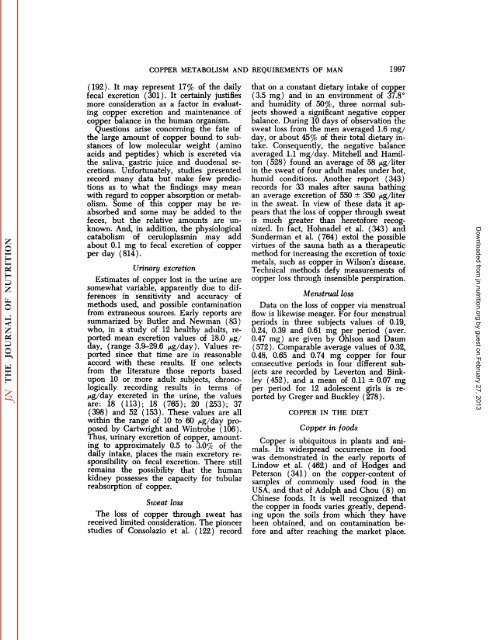conspectus of researchon copper metabolism and requirements
conspectus of researchon copper metabolism and requirements
conspectus of researchon copper metabolism and requirements
Create successful ePaper yourself
Turn your PDF publications into a flip-book with our unique Google optimized e-Paper software.
COPPER METABOLISM AND REQUIREMENTS OF MAN 1997<br />
(192). It may represent 17% <strong>of</strong> the daily<br />
fecal excretion (301). It certainly justifies<br />
more consideration as a factor in evaluat<br />
ing <strong>copper</strong> excretion <strong>and</strong> maintenance <strong>of</strong><br />
<strong>copper</strong> balance in the human organism.<br />
Questions arise concerning the fate <strong>of</strong><br />
the large amount <strong>of</strong> <strong>copper</strong> bound to sub<br />
stances <strong>of</strong> low molecular weight (amino<br />
acids <strong>and</strong> peptides) which is excreted via<br />
the saliva, gastric juice <strong>and</strong> duodenal se<br />
cretions. Unfortunately, studies presented<br />
record many data but make few predic<br />
tions as to what the findings may mean<br />
with regard to <strong>copper</strong> absorption or metab<br />
olism. Some <strong>of</strong> this <strong>copper</strong> may be reabsorbed<br />
<strong>and</strong> some may be added to the<br />
fèces, but the relative amounts are un<br />
known. And, in addition, the physiological<br />
catabolism <strong>of</strong> ceruloplasmin may add<br />
about 0.1 mg to fecal excretion <strong>of</strong> <strong>copper</strong><br />
per day (814).<br />
Urinary excretion<br />
Estimates <strong>of</strong> <strong>copper</strong> lost in the urine are<br />
somewhat variable, apparently due to dif<br />
ferences in sensitivity <strong>and</strong> accuracy <strong>of</strong><br />
methods used, <strong>and</strong> possible contamination<br />
from extraneous sources. Early reports are<br />
summarized by Butler <strong>and</strong> Newman (83)<br />
who, in a study <strong>of</strong> 12 healthy adults, re<br />
ported mean excretion values <strong>of</strong> 18.0 jug/<br />
day, (range 3.9-29.6 fig/day). Values re<br />
ported since that time are in reasonable<br />
accord with these results. If one selects<br />
from the literature those reports based<br />
upon 10 or more adult subjects, chrono<br />
logically recording results in terms <strong>of</strong><br />
/«.g/dayexcreted in the urine, the values<br />
are: 18 (113); 18 (765); 20 (253); 37<br />
(398) <strong>and</strong> 52 (153). These values are all<br />
within the range <strong>of</strong> 10 to 60 /¿g/daypro<br />
posed by Cartwright <strong>and</strong> Wintrobe ( 106).<br />
Thus, urinary excretion <strong>of</strong> <strong>copper</strong>, amount<br />
ing to approximately 0.5 to 3.0$ <strong>of</strong> the<br />
daily intake, places the main excretory re<br />
sponsibility on fecal excretion. There still<br />
remains the possibility that the human<br />
kidney possesses the capacity for tubular<br />
reabsorption <strong>of</strong> <strong>copper</strong>.<br />
Sweat loss<br />
The loss <strong>of</strong> <strong>copper</strong> through sweat has<br />
received limited consideration. The pioneer<br />
studies <strong>of</strong> Consolazio et al. ( 122) record<br />
that on a constant dietary intake <strong>of</strong> <strong>copper</strong><br />
(3.5 mg) <strong>and</strong> in an environment <strong>of</strong> 37.8°<br />
<strong>and</strong> humidity <strong>of</strong> 50$;, three normal sub<br />
jects showed a significant negative <strong>copper</strong><br />
balance. During 10 days <strong>of</strong> observation the<br />
sweat loss from the men averaged 1.6 mg/<br />
day, or about 45% <strong>of</strong> their total dietary in<br />
take. Consequently, the negative balance<br />
averaged 1.1 mg/day. Mitchell <strong>and</strong> Hamil<br />
ton (528) found an average <strong>of</strong> 58 /¿g/li ter<br />
in the sweat <strong>of</strong> four adult males under hot,<br />
humid conditions. Another report (343)<br />
records for 33 males after sauna bathing<br />
an average excretion <strong>of</strong> 550 ±350 /^g/liter<br />
in the sweat. In view <strong>of</strong> these data it ap<br />
pears that the loss <strong>of</strong> <strong>copper</strong> through sweat<br />
is much greater than heret<strong>of</strong>ore recog<br />
nized. In fact, Hohnadel et al. (343) <strong>and</strong><br />
Sunderman et al. (764) extol the possible<br />
virtues <strong>of</strong> the sauna bath as a therapeutic<br />
method for increasing the excretion <strong>of</strong> toxic<br />
metals, such as <strong>copper</strong> in Wilson's disease.<br />
Technical methods defy measurements <strong>of</strong><br />
<strong>copper</strong> loss through insensible perspiration.<br />
Menstrual loss<br />
Data on the loss <strong>of</strong> <strong>copper</strong> via menstrual<br />
flow is likewise meager. For four menstrual<br />
periods in three subjects values <strong>of</strong> 0.19,<br />
0.24, 0.39 <strong>and</strong> 0.61 mg per period (aver.<br />
0.47 mg) are given by Ohlson <strong>and</strong> Daum<br />
(572). Comparable average values <strong>of</strong> 0.32,<br />
0.48, 0.65 <strong>and</strong> 0.74 mg <strong>copper</strong> for four<br />
consecutive periods in four different sub<br />
jects are recorded by Leverton <strong>and</strong> Binkley<br />
(452), <strong>and</strong> a mean <strong>of</strong> 0.11 ±0.07 mg<br />
per period for 12 adolescent girls is re<br />
ported by Greger <strong>and</strong> Buckley (278 ).<br />
COPPER IN THE DIET<br />
Copper in foods<br />
Copper is ubiquitous in plants <strong>and</strong> ani<br />
mals. Its widespread occurrence in food<br />
was demonstrated in the early reports <strong>of</strong><br />
Lindow et al. (462) <strong>and</strong> <strong>of</strong> Hodges <strong>and</strong><br />
Peterson (341) on the <strong>copper</strong>-content <strong>of</strong><br />
samples <strong>of</strong> commonly used food in the<br />
USA, <strong>and</strong> that <strong>of</strong> Adolph <strong>and</strong> Chou (8) on<br />
Chinese foods. It is well recognized that<br />
the <strong>copper</strong> in foods varies greatly, depend<br />
ing upon the soils from which they have<br />
been obtained, <strong>and</strong> on contamination be<br />
fore <strong>and</strong> after reaching the market place.<br />
Downloaded from<br />
jn.nutrition.org<br />
by guest on February 27, 2013
















